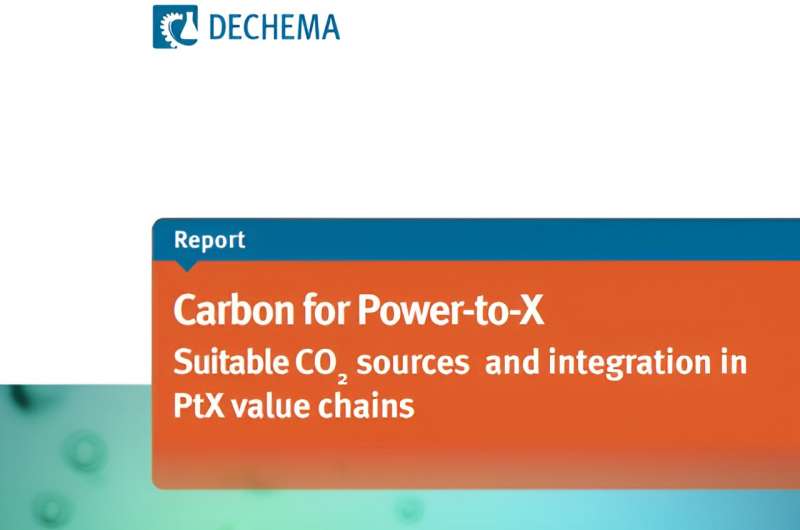Report explores possibilities of capturing and using carbon dioxide for sustainable production routes

A new DECHEMA report "Carbon for Power-to-X—Suitable CO2 sources and integration in PtX value chains" deals with possibilities of capturing and utilizing carbon dioxide for sustainable production routes. Carbon dioxide can serve as a carbon feed for numerous climate friendly commodities produced with Power-to-X technologies. The report elaborates on point sources and state-of-the-art capture methods.
Climate neutral commodities produced with sustainable power—that is the promise of Power-to-X (PtX). The PtX concept unites numerous innovative technologies to establish value chains that are fueled by renewable energy. For this reason, PtX is considered to be a relevant contribution for the industrial energy transition. However, for many PtX routes, carbon is required to substitute materials and energy carriers which are conventionally based on fossil resources.
Carbon dioxide (CO2) is a suitable source of carbon, since it can serve as the starting point to produce fuels, polymers, and a myriad of base chemicals. In the recent report, DECHEMA identifies point sources and describes various technologies to capture CO2.
"Today's value chains of most commonly used products are immensely shaped by the petrochemical industry, which deliver basic chemicals like methanol," says co-author Luisa López. "These fossil-based molecules are currently produced in megaton scale. PtX enables us to establish alternative production routes for these essential compounds, based on CO2."
Currently, CO2 is mainly a waste product in many sectors. About 37 gigatons of CO2 per year are emitted globally into the atmosphere. Although efforts to minimize these emissions are being carried out, remaining CO2 flows can be utilized as feedstock for PtX production.
The report shows that CO2 can be acquired from energy and industry sectors, biogenic processes, waste and wastewater and the atmospheric air. Sources in which the use of fossil resources are involved, have additional implications concerning sustainability, and potential lock-in effects must be considered. Therefore, CO2 sources with a closed carbon cycle are more suitable to achieve sustainability goals.
"Biogenic sources and direct air capture (DAC) could serve as sustainable carbon feed that is most accepted, due to the possibility of achieving a closed carbon cycle," says co-author Dr. Chokri Boumrifak. "Nevertheless, biomass is in great demand in other sectors as well, and its capacities are limited.
"DAC, as a theoretically unlimited available source, requires on the other hand high amounts of energy compared to other sources, and its large-scale applications are still very cost intensive. Therefore, unavoidable CO2 emissions from the industrial sector should be considered as an additional point source."
These technologies are already well developed, and their application depends on factors such as the quality of the stream composition, efficiency, and cost-effectiveness. Amine gas treatment is among all CO2 separation methods the most matured technology and has already been widely commercialized.
Several other separation techniques, namely cryogenic separation, pressure swing adsorption, vacuum pressure swing adsorption, membrane separation, and chemical looping combustion are employed in carbon dioxide separation.
For combustion processes, the report demonstrates how carbon capture can be applied via different approaches. The simplest method consists on extracting CO2 from the exhaust gas after combustion with air. Much more advanced are approaches that either pre-treat the fuel via gasification or combust the fuel with pure oxygen to gain CO2 in higher purity. Moreover, CO2 can be captured directly from the atmosphere.
The captured CO2 can be utilized through either already existing production routes or newly established processes to synthesize chemicals with added value. The primary production routes with CO2 as feedstock include methanol synthesis (as a precursor for fuels, polymers, acids, etc.), Fischer-Tropsch (which produces fuels, waxes, naphtha and methane) and carbonylation processes (such as ibuprofen, acrylic glass etc.).
Adaption of these production routes to a PtX concept require novel technologies to convert CO2 to the respective precursor. One of the most advanced use-case for PtX are Power-to-Liquid (PtL) processes for the production of synthetic hydrocarbons such as fuels.
How CO2 will be integrated in the future depends on regulatory aspects that clarify which carbon source can be labeled as sustainable and infrastructure measures to supply carbon where it is needed. Besides these uncertainties, CO2 still will be a key component to push forward PtX products as an alternative to fossil-based materials and fuels.
More information: Report: Carbon for Power-to-X: Suitable CO2 sources and integration in PtX value chains
No comments:
Post a Comment